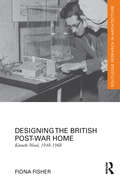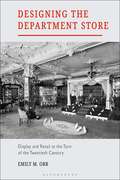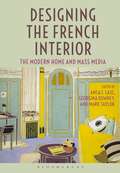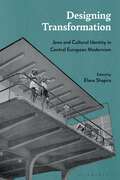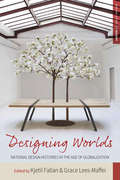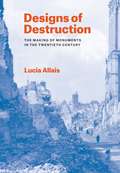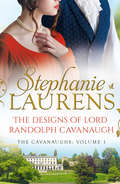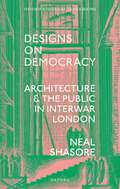- Table View
- List View
Designing the British Post-War Home: Kenneth Wood, 1948-1968 (Routledge Research in Architecture)
by Fiona FisherIn Designing the British Post-War Home Fiona Fisher explores the development of modern domestic architecture in Britain through a detailed study of the work of the successful Surrey-based architectural practice of Kenneth Wood. Wood’s firm is representative of a geographically distinct category of post-war architectural and design practice - that of the small private practice that flourished in Britain’s expanding suburbs after the removal of wartime building restrictions. Such firms, which played an important role in the development of British domestic design, are currently under-represented within architectural histories of the period. The private house represents an important site in which new spatial, material and aesthetic parameters for modern living were defined after the Second World War. Within a British context, the architect-designed private house remained an important ‘vehicle for the investigation of architectural ideas’ by second generation modernist architects and designers. Through a series of case study houses, designed by Wood’s firm, the book reconsiders the progress of modern domestic architecture in Britain and demonstrates the ways in which architectural discourse and practice intersected with the experience, performance and representation of domestic modernity in post-war Britain.
Designing the Department Store: Display and Retail at the Turn of the Twentieth Century
by Emily M. OrrThe book builds an original argument for the department store as a significant site of design production, and therefore offers an alternative interpretation to the mainstream focus on consumption within retail history. Emily M. Orr presents a fresh perspective on the rise of modern urban consumer culture, of which the department store was a key feature. By investigating the production processes of display as well as fascinating information about display-making's tools and technologies, the skills of the displayman and the meaning and context of design decisions which shaped the final visual effect are revealed. In addition, the book identifies and isolates 'display' as a distinct moment in the life of the commodity, and understands it as an influential channel of mediation in the shopping experience. The assembly and interpretation of a diverse range of previously unexplored primary resources and archives yields fascinating new evidence, showing how display achieved an agency which transformed everyday objects into commodities and made consumers out of passersby.
Designing the Department Store: Display and Retail at the Turn of the Twentieth Century
by Emily M. OrrThe book builds an original argument for the department store as a significant site of design production, and therefore offers an alternative interpretation to the mainstream focus on consumption within retail history. Emily M. Orr presents a fresh perspective on the rise of modern urban consumer culture, of which the department store was a key feature. By investigating the production processes of display as well as fascinating information about display-making's tools and technologies, the skills of the displayman and the meaning and context of design decisions which shaped the final visual effect are revealed. In addition, the book identifies and isolates 'display' as a distinct moment in the life of the commodity, and understands it as an influential channel of mediation in the shopping experience. The assembly and interpretation of a diverse range of previously unexplored primary resources and archives yields fascinating new evidence, showing how display achieved an agency which transformed everyday objects into commodities and made consumers out of passersby.
Designing the European Union: From Paris to Lisbon (Palgrave Studies in European Union Politics)
by Finn LaursenThis book outlines the content of the main treaties that form the 'constitutional' basis of the European Union and analyses changes in these over time. The EU has expanded its policy scope and taken in many more members transferring powers to common supranational institutions in a way seen nowhere else in the world.
Designing the French Interior: The Modern Home and Mass Media
by Anca I. Lasc Georgina Downey Mark TaylorDesigning the French Interior traces France's central role in the development of the modern domestic interior, from the pre-revolutionary period to the 1970s, and addresses the importance of various media, including drawings, prints, pattern books, illustrated magazines, department store catalogs, photographs, guidebooks, and films, in representing and promoting French interior design to a wider audience. Contributors to this original volume identify and historicize the singularity of the modern French domestic interior as a generator of reproducible images, a site for display of both highly crafted and mass-produced objects, and the direct result of widely-circulated imagery in its own right. This important volume enables an invaluable new understanding of the relationship between architecture, interior spaces, material cultures, mass media and modernity.
Designing the French Interior: The Modern Home and Mass Media
by Anca I. Lasc Georgina Downey Mark TaylorDesigning the French Interior traces France's central role in the development of the modern domestic interior, from the pre-revolutionary period to the 1970s, and addresses the importance of various media, including drawings, prints, pattern books, illustrated magazines, department store catalogs, photographs, guidebooks, and films, in representing and promoting French interior design to a wider audience. Contributors to this original volume identify and historicize the singularity of the modern French domestic interior as a generator of reproducible images, a site for display of both highly crafted and mass-produced objects, and the direct result of widely-circulated imagery in its own right. This important volume enables an invaluable new understanding of the relationship between architecture, interior spaces, material cultures, mass media and modernity.
Designing the Urban Renaissance: Sustainable and competitive place making in England
by Francesco VescoviThis book is an academic essay about the urban regeneration policies which have been changing the physical - and partly social - outlook of many English cities during the last 10-15 years, eventually giving birth to a process which is also known as ‘Urban Renaissance’. The main focus is on urban design: the way it has been promoted by the government as an important means for delivering attractive places in more sustainable and competitive cities. The research describes the support given to local authorities for this purpose through new laws and powers, the publishing of planning and design manuals and the delivery of especially dedicated funds, bodies and programmes. It also explores the character and purpose of new developments such as scientific parks, creative/cultural quarters, retail and commercial dis-tricts, public realm works, describing recurring design rules and features. Readers interested in urban policies, architecture and the built environment will find a concise yet comprehensive explanation, enriched by more than a hundred pictures, on why and how many towns and cities like Birmingham, Nottingham, Leicester or Sheffield have been changing during the last decade.
Designing Transformation: Jews and Cultural Identity in Central European Modernism
by Elana ShapiraJewish designers and architects played a key role in shaping the interwar architecture of Central Europe, and in the respective countries where they settled following the Nazi's rise to power. This book explores how Jewish architects and patrons influenced and reformed the design of towns and cities through commercial buildings, urban landscaping and other material culture. It also examines how modern identities evolved in the context of migration, commercial and professional networks, and in relation to the conflict between nationalist ideologies and international aspirations in Central Europe and beyond. Pointing to the production within cultural platforms shared by Jews and Christians, the book's research sheds new light on the importance of integrating Jews into Central European design and aesthetic history. Leading historians, curators, archivists and architects present their critical analyses further to 'design' the past and push forward a transformation in the historical consciousness of Central Europe. By reconsidering the seminal role of Central European émigré and exiled architects and designers in shaping today's global design cultures, this book further strengthens humanistic, progressive and pluralistic cultural trends in Europe today.
Designing Transformation: Jews and Cultural Identity in Central European Modernism
Jewish designers and architects played a key role in shaping the interwar architecture of Central Europe, and in the respective countries where they settled following the Nazi's rise to power. This book explores how Jewish architects and patrons influenced and reformed the design of towns and cities through commercial buildings, urban landscaping and other material culture. It also examines how modern identities evolved in the context of migration, commercial and professional networks, and in relation to the conflict between nationalist ideologies and international aspirations in Central Europe and beyond. Pointing to the production within cultural platforms shared by Jews and Christians, the book's research sheds new light on the importance of integrating Jews into Central European design and aesthetic history. Leading historians, curators, archivists and architects present their critical analyses further to 'design' the past and push forward a transformation in the historical consciousness of Central Europe. By reconsidering the seminal role of Central European émigré and exiled architects and designers in shaping today's global design cultures, this book further strengthens humanistic, progressive and pluralistic cultural trends in Europe today.
Designing US Economic Policy: An Analytical Biography of Leon H. Keyserling
by W. BrazeltonIn Designing US Economic Policy , W. Robert Brazelton analyzes the development of US economic policy in the aftermath of the Second World War. As the world struggled to recover from the massive wartime expenditure, it was essential that economic policy not repeat the mistakes of the prewar era which sparked the 1930s Depression. These policies included Truman's New Deal, which helped shape both the economic and social climate of the USA today.
Designing West Africa: Prelude to 21st Century Calamity
by P. SchwabMany African nations are now described as 'fourth world nations', ones which essentially have no future. How could this have happened? Through the scope of the 1960's, the first decade of African independence, Peter Schwab presents a compelling and provocative answer to this question. Designing West Africa tells the story of a pivotal decade in African history, when the fate of the continent was decided. Focusing on the six most visible leaders of the period - painting detailed portraits of them both as leaders and as people - Schwab looks at how Africa served as a ground to play out larger international conflicts, namely the Cold War. He does not fall back on blaming non-African involvement for the failure to build a visible leadership for the continent; rather he critiques the African leaders themselves for their individual failings.
Designing Worlds: National Design Histories in an Age of Globalization (Making Sense of History #24)
by 9781785331565From consumer products to architecture to advertising to digital technology, design is an undeniably global phenomenon. Yet despite their professed transnational perspective, historical studies of design have all too often succumbed to a bias toward Western, industrialized nations. This diverse but rigorously curated collection recalibrates our understanding of design history, reassessing regional and national cultures while situating them within an international context. Here, contributors from five continents offer nuanced studies that range from South Africa to the Czech Republic, all the while sensitive to the complexities of local variation and the role of nation-states in identity construction.
Designology: Studies on Planning for Action (Praxiology)
by Wojciech W. Gasparski Tufan OrelThe more complex a human action is, the greater the need to formulate a plan of action, devise a method of implementation, and evaluate its execution. Such preparation is called design or planning, and can be defined as a conceptual preparation for action. Design and planning by themselves are so complex and important that they need informed preparation, which calls for systematic designological studies.This volume brings together original contributions of researchers and practitioners in design theory, design research, and design studies. Its main purpose is to highlight the possibilities of the discipline of designology. Doing and thinking, or thinking and doing, whatever the order, are intertwined. That is why praxiology, the science of action, defines design as a conceptual preparation of action.Included here are contributions from Jack Brzezinski, Eduardo Corte-Real, Nigel Cross, Michel Faucheux, Joelle Forest, Wojciech W. Gasparski, Ioannes B. Kapelouzos, Thorbjoern Mann, Tom Maver, Tarkko Oksala, Tufan Orel, Sevil Saryldz, and Ladislav Tondl. Designology is the latest volume in Transaction's highly regarded Praxiology series.
Designology: Studies on Planning for Action (Praxiology)
by Wojciech W. Gasparski Tufan OrelThe more complex a human action is, the greater the need to formulate a plan of action, devise a method of implementation, and evaluate its execution. Such preparation is called design or planning, and can be defined as a conceptual preparation for action. Design and planning by themselves are so complex and important that they need informed preparation, which calls for systematic designological studies.This volume brings together original contributions of researchers and practitioners in design theory, design research, and design studies. Its main purpose is to highlight the possibilities of the discipline of designology. Doing and thinking, or thinking and doing, whatever the order, are intertwined. That is why praxiology, the science of action, defines design as a conceptual preparation of action.Included here are contributions from Jack Brzezinski, Eduardo Corte-Real, Nigel Cross, Michel Faucheux, Joelle Forest, Wojciech W. Gasparski, Ioannes B. Kapelouzos, Thorbjoern Mann, Tom Maver, Tarkko Oksala, Tufan Orel, Sevil Saryldz, and Ladislav Tondl. Designology is the latest volume in Transaction's highly regarded Praxiology series.
Designs for Street Fronts, Suburban Houses and Cottages (Dover Architecture)
by C. C. Miller M. F. CummingsExcellent sourcebook includes elevations of building fronts as well as enlarged drawings of architectural elements incorporated in these facades: residential entrances, cornices, a curved roof, dormer window, and much more. Indispensable archive for preservationists, restorationists, architectural historians, and urban archaeologists. 714 illustrations on 52 plates.
Designs of Destruction: The Making of Monuments in the Twentieth Century
by Lucia AllaisThe twentieth century was the most destructive in human history, but from its vast landscapes of ruins was born a new architectural type: the cultural monument. In the wake of World War I, an international movement arose which aimed to protect architectural monuments in large numbers, and regardless of style, hoping not only to keep them safe from future conflicts, but also to make them worthy of protection from more quotidian forms of destruction. This movement was motivated by hopeful idealism as much as by a pragmatic belief in bureaucracy. An evolving group—including architects, intellectuals, art historians, archaeologists, curators, and lawyers—grew out of the new diplomacy of the League of Nations. During and after World War II, it became affiliated with the Allied Military Government, and was eventually absorbed by the UN as UNESCO. By the 1970s, this organization had begun granting World Heritage status to a global register of significant sites—from buildings to bridges, shrines to city centers, ruins to colossi. Examining key episodes in the history of this preservation effort—including projects for the Parthenon, for the Cathedral of St-Lô, the temples of Abu Simbel, and the Bamyian Buddahs —Lucia Allais demonstrates how the group deployed the notion of culture to shape architectural sites, and how architecture in turn shaped the very idea of global culture. More than the story of an emergent canon, Designs of Destruction emphasizes how the technical project of ensuring various buildings’ longevity jolted preservation into establishing a transnational set of codes, values, practices. Yet as entire nations’ monumental geographies became part of survival plans, Allais also shows, this paradoxically helped integrate technologies of destruction—from bombs to bulldozers—into cultural governance. Thus Designs of Destruction not only offers a fascinating narrative of cultural diplomacy, based on extensive archival findings; it also contributes an important new chapter in the intellectual history of modernity by showing the manifold ways architectural form is charged with concretizing abstract ideas and ideals, even in its destruction.
Designs of Destruction: The Making of Monuments in the Twentieth Century
by Lucia AllaisThe twentieth century was the most destructive in human history, but from its vast landscapes of ruins was born a new architectural type: the cultural monument. In the wake of World War I, an international movement arose which aimed to protect architectural monuments in large numbers, and regardless of style, hoping not only to keep them safe from future conflicts, but also to make them worthy of protection from more quotidian forms of destruction. This movement was motivated by hopeful idealism as much as by a pragmatic belief in bureaucracy. An evolving group—including architects, intellectuals, art historians, archaeologists, curators, and lawyers—grew out of the new diplomacy of the League of Nations. During and after World War II, it became affiliated with the Allied Military Government, and was eventually absorbed by the UN as UNESCO. By the 1970s, this organization had begun granting World Heritage status to a global register of significant sites—from buildings to bridges, shrines to city centers, ruins to colossi. Examining key episodes in the history of this preservation effort—including projects for the Parthenon, for the Cathedral of St-Lô, the temples of Abu Simbel, and the Bamyian Buddahs —Lucia Allais demonstrates how the group deployed the notion of culture to shape architectural sites, and how architecture in turn shaped the very idea of global culture. More than the story of an emergent canon, Designs of Destruction emphasizes how the technical project of ensuring various buildings’ longevity jolted preservation into establishing a transnational set of codes, values, practices. Yet as entire nations’ monumental geographies became part of survival plans, Allais also shows, this paradoxically helped integrate technologies of destruction—from bombs to bulldozers—into cultural governance. Thus Designs of Destruction not only offers a fascinating narrative of cultural diplomacy, based on extensive archival findings; it also contributes an important new chapter in the intellectual history of modernity by showing the manifold ways architectural form is charged with concretizing abstract ideas and ideals, even in its destruction.
Designs of Destruction: The Making of Monuments in the Twentieth Century
by Lucia AllaisThe twentieth century was the most destructive in human history, but from its vast landscapes of ruins was born a new architectural type: the cultural monument. In the wake of World War I, an international movement arose which aimed to protect architectural monuments in large numbers, and regardless of style, hoping not only to keep them safe from future conflicts, but also to make them worthy of protection from more quotidian forms of destruction. This movement was motivated by hopeful idealism as much as by a pragmatic belief in bureaucracy. An evolving group—including architects, intellectuals, art historians, archaeologists, curators, and lawyers—grew out of the new diplomacy of the League of Nations. During and after World War II, it became affiliated with the Allied Military Government, and was eventually absorbed by the UN as UNESCO. By the 1970s, this organization had begun granting World Heritage status to a global register of significant sites—from buildings to bridges, shrines to city centers, ruins to colossi. Examining key episodes in the history of this preservation effort—including projects for the Parthenon, for the Cathedral of St-Lô, the temples of Abu Simbel, and the Bamyian Buddahs —Lucia Allais demonstrates how the group deployed the notion of culture to shape architectural sites, and how architecture in turn shaped the very idea of global culture. More than the story of an emergent canon, Designs of Destruction emphasizes how the technical project of ensuring various buildings’ longevity jolted preservation into establishing a transnational set of codes, values, practices. Yet as entire nations’ monumental geographies became part of survival plans, Allais also shows, this paradoxically helped integrate technologies of destruction—from bombs to bulldozers—into cultural governance. Thus Designs of Destruction not only offers a fascinating narrative of cultural diplomacy, based on extensive archival findings; it also contributes an important new chapter in the intellectual history of modernity by showing the manifold ways architectural form is charged with concretizing abstract ideas and ideals, even in its destruction.
Designs of Destruction: The Making of Monuments in the Twentieth Century
by Lucia AllaisThe twentieth century was the most destructive in human history, but from its vast landscapes of ruins was born a new architectural type: the cultural monument. In the wake of World War I, an international movement arose which aimed to protect architectural monuments in large numbers, and regardless of style, hoping not only to keep them safe from future conflicts, but also to make them worthy of protection from more quotidian forms of destruction. This movement was motivated by hopeful idealism as much as by a pragmatic belief in bureaucracy. An evolving group—including architects, intellectuals, art historians, archaeologists, curators, and lawyers—grew out of the new diplomacy of the League of Nations. During and after World War II, it became affiliated with the Allied Military Government, and was eventually absorbed by the UN as UNESCO. By the 1970s, this organization had begun granting World Heritage status to a global register of significant sites—from buildings to bridges, shrines to city centers, ruins to colossi. Examining key episodes in the history of this preservation effort—including projects for the Parthenon, for the Cathedral of St-Lô, the temples of Abu Simbel, and the Bamyian Buddahs —Lucia Allais demonstrates how the group deployed the notion of culture to shape architectural sites, and how architecture in turn shaped the very idea of global culture. More than the story of an emergent canon, Designs of Destruction emphasizes how the technical project of ensuring various buildings’ longevity jolted preservation into establishing a transnational set of codes, values, practices. Yet as entire nations’ monumental geographies became part of survival plans, Allais also shows, this paradoxically helped integrate technologies of destruction—from bombs to bulldozers—into cultural governance. Thus Designs of Destruction not only offers a fascinating narrative of cultural diplomacy, based on extensive archival findings; it also contributes an important new chapter in the intellectual history of modernity by showing the manifold ways architectural form is charged with concretizing abstract ideas and ideals, even in its destruction.
The Designs Of Lord Randolph Cavanaugh: The Governess Game / Mistress At Midnight / Scars Of Betrayal / Rake Most Likely To Rebel / Rake Most Likely To Thrill / The Designs Of Lord Randolph Cavanaugh (Hq Fiction Ebook Ser. #1)
by Stephanie Laurens#1 New York Times bestselling author Stephanie Laurens returns with a new series that captures the simmering desires and intrigues of early Victorians as only she can. ‘Stephanie Laurens’ heroines are marvelous tributes to Georgette Heyer: feisty and strong.’ Cathy Kelly
Designs on Democracy: Architecture and the Public in Interwar London (Oxford Historical Monographs)
by Neal ShasoreDesigns on Democracy examines a pivotal period in the formation of the modern profession of architecture in Britain. It shows how architects sought to meet the newly articulated demands of a mass democracy in the wake of the First World War. It does so by providing a vivid picture of architectural culture in interwar London, the Imperial metropolis, drawing on histories of design, practice, professionalism, and representation. Most accounts of this period tend to deal exclusively with the emergence of Modernism; this study takes a different approach, encompassing a much broader perspective on the liberal professional consensus that held sway, including architecture's mainstream and its so-called avant-garde. Readers will encounter a number of unexpected narratives, episodes, and projects: from the British Empire Exhibition at Wembley to the rebuilding of Waterloo Bridge; from the impact of the Great Slump to the passing of the first Architects Registration Act (1931); from Trystan Edwards's radical housing campaigns to the Londoners' League's unorthodox preservationism. Pulling in a range of evidence and sources - periodicals, exhibitions, photographs, and films, alongside architecture - it evokes architectural culture by listening carefully to the tenor of its discourse. Architecture's public realm is thus analysed through sometimes surprising phrases: 'manners' to understand ideals of public propriety, 'vigilance' to explore public proprietorship, 'slump' to contextualise the emergence of public relations, 'machine-craft' to understand the forging of public institutions. The volume spans the excitable discussions about the reconstruction of the profession for a democratic age after WWI, to reconstruction and planning following WWII, providing an ambitious revision of how we can understand twentieth century architecture in Britain.
Designs on Democracy: Architecture and the Public in Interwar London (Oxford Historical Monographs)
by Neal ShasoreDesigns on Democracy examines a pivotal period in the formation of the modern profession of architecture in Britain. It shows how architects sought to meet the newly articulated demands of a mass democracy in the wake of the First World War. It does so by providing a vivid picture of architectural culture in interwar London, the Imperial metropolis, drawing on histories of design, practice, professionalism, and representation. Most accounts of this period tend to deal exclusively with the emergence of Modernism; this study takes a different approach, encompassing a much broader perspective on the liberal professional consensus that held sway, including architecture's mainstream and its so-called avant-garde. Readers will encounter a number of unexpected narratives, episodes, and projects: from the British Empire Exhibition at Wembley to the rebuilding of Waterloo Bridge; from the impact of the Great Slump to the passing of the first Architects Registration Act (1931); from Trystan Edwards's radical housing campaigns to the Londoners' League's unorthodox preservationism. Pulling in a range of evidence and sources - periodicals, exhibitions, photographs, and films, alongside architecture - it evokes architectural culture by listening carefully to the tenor of its discourse. Architecture's public realm is thus analysed through sometimes surprising phrases: 'manners' to understand ideals of public propriety, 'vigilance' to explore public proprietorship, 'slump' to contextualise the emergence of public relations, 'machine-craft' to understand the forging of public institutions. The volume spans the excitable discussions about the reconstruction of the profession for a democratic age after WWI, to reconstruction and planning following WWII, providing an ambitious revision of how we can understand twentieth century architecture in Britain.
Designs on the Past: How Hollywood Created the Ancient World
by Lloyd Llewellyn-JonesThe first 50-year retrospective of the most tumultuous year of the 1960s for activism and radical politics
Designs on the Past: How Hollywood Created the Ancient World (Screening Antiquity Ser.)
by Lloyd Llewellyn-JonesExplores how a new generation are redefining what it means to be a Muslim in Britain today
The Desirable Duchess: Regency Royal 14 (Regency Royal)
by M.C. BeatonLovely Alice Lacey was a true Incomparable, and her marriage to the Duke of Ferrant was the event of the Season. But almost none realized, however, that Alice was secretly in love with someone else - or that she had confided her feelings to a clever talking mynah bird who determined to announce these intimacies at the moment of the couple's wedding!Now the gossip mongers were relentless. Alice's marriage had started out and remained cold and impersonal, and her new husband was already rumored to be taken with another woman.Before she even realized what was happening, Alice found herself in world of opposites: she found out that the man she had thought she loved was something other than what he seemed, and the man she had married was something far more than she'd hoped. Her last hope and redemption had to be convincing the man she had wed that they were in love.
